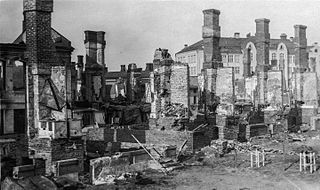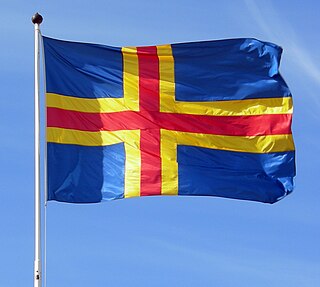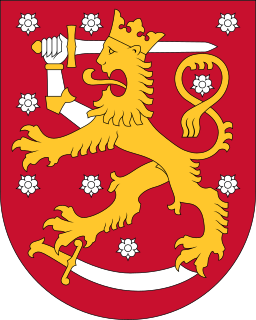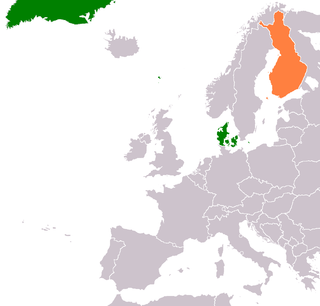
The Finnish Civil War was a civil war in Finland in 1918 fought for the leadership and control of the country between White Finland and the Finnish Socialist Workers' Republic during the country's transition from a grand duchy of the Russian Empire to an independent state. The clashes took place in the context of the national, political, and social turmoil caused by World War I in Europe. The war was fought between the "Reds", led by a section of the Social Democratic Party, and the "Whites", conducted by the conservative-based senate and the German Imperial Army. The paramilitary Red Guards, which were composed of industrial and agrarian workers, controlled the cities and industrial centers of southern Finland. The paramilitary White Guards, which consisted of land owners and those in the middle- and upper-classes, controlled rural central and northern Finland, and were led by General C. G. E. Mannerheim.

The history of Finland begins around 9,000 BC during the end of the last glacial period. Stone Age cultures were Kunda, Comb Ceramic, Corded Ware, Kiukainen, and Pöljä cultures. The Finnish Bronze Age started in approximately 1,500 BC and the Iron Age started in 500 BC and lasted until 1,300 AD. Finnish Iron Age cultures can be separated into Finnish proper, Tavastian and Karelian cultures. The earliest written sources mentioning Finland start to appear from the 12th century onwards when the Catholic Church started to gain a foothold in Southwest Finland.

The flag of Finland, also called siniristilippu, dates from the beginning of the 20th century. On a white background, it features a blue Nordic cross, which represents Christianity.

Baron Carl Gustaf Emil Mannerheim was a Finnish military leader and statesman. He served as the military leader of the Whites in the Finnish Civil War of 1918, as Regent of Finland (1918–1919), as commander-in-chief of Finland's defence forces during the period of World War II (1939–1945), as Marshal of Finland (1942–), and as the sixth president of Finland (1944–1946).

Suomenlinna, or Sveaborg, is an inhabited sea fortress the Suomenlinna district is on eight islands of which six have been fortified; it is about 4 km southeast of the city center of Helsinki, the capital of Finland. Suomenlinna is popular with tourists and locals who enjoy it as a picturesque picnic site. Originally named Sveaborg, or Viapori as referred to by Finnish-speaking Finns, it was renamed in Finnish to Suomenlinna in 1918 for patriotic and nationalistic reasons, though it is still known by its original name in Sweden and by Swedish-speaking Finns.

The history of Åland can be traced back to when Humans first reached the archipelago in the Neolithic period ca. 4000BC.

National Guard is the name used by a wide variety of current and historical uniformed organizations in different countries. The original National Guard was formed during the French Revolution around a cadre of defectors from the French Guards.
The Young Finnish Party or Constitutional-Fennoman Party was a liberal and nationalist political party in the Grand Duchy of Finland. It began as an upper-class reformist movement during the 1870s and formed as a political party in 1894.

Orimattila is a town in Päijänne Tavastia region, Finland. The southern part of Lahti is connected to the village of Orimattila, which is located in the region of Pennala. There are also several municipalities in the area, such as Iitti, Kärkölä, Lahti, Mäntsälä, and Pukkila.

The coat of arms of Finland is a crowned lion on a red field, the right foreleg replaced with an armoured human arm brandishing a sword, trampling on a sabre with the hindpaws. The coat of arms was originally created around the year 1580.

Rakvere is a town in northern Estonia and the administrative centre of the Lääne-Viru maakond (county), 20 km south of the Gulf of Finland of the Baltic Sea. Rakvere is the 8th most populous urban area in Estonia. Rakvere has a total area of 10.75 square kilometres, and although about 15% of it is covered by forest, the city is still populated so densely as to make it the third most densely populated city in Estonia. From the 13th century until the early 20th century, Rakvere was more widely known by its historical German name, Wesenberg(h).

Part of the famous Hotel Gellért in Buda, the Gellért Thermal Baths and Swimming Pool, also known simply as the Gellért Baths, is a bath complex in Budapest in Hungary.

Home guard is a title given to various military organizations at various times, with the implication of an emergency or reserve force raised for local defense.

Finland declared its independence on 6 December 1917. The formal Declaration of Independence was only part of the long process leading to the independence of Finland.

Messukylä is a former municipality of Finland which was annexed by the city of Tampere in 1947. The medieval stone church in Messukylä is the oldest building in Tampere. During the Civil War (1918), Messukylä was the scene of heavy battles around both the medieval and new churches.

The Kingdom of Finland was a failed attempt to establish a monarchy in Finland in the aftermath of the Finnish Declaration of Independence from Russia in December 1917 and the Finnish Civil War from January–May 1918. The victorious Whites in the Parliament of Finland began the process of turning Finland into a kingdom and creating a monarchy. Although the country was legally a kingdom for over a year, that was headed by a regent; the king-elect Frederick Charles never reigned nor came to Finland following Germany's defeat in World War I, and republican victories in subsequent elections resulted in the country becoming a republic.

Turunmaa was a Finnish gunboat built in 1918. She served in the Finnish Navy during World War II. The ship was named after Turuma, a type of frigate designed for use in shallow waters of the archipelago and served in the Swedish Archipelago fleet in the late 18th century. The frigates had in turn been named after the region of Finland.

Denmark–Finland relations are foreign relations between Denmark and Finland. Denmark has an embassy in Helsinki. Finland has an embassy in Copenhagen. Both countries are part of the Nordic Council. Denmark officially recognized Finland's independence in 1918 and diplomatic relations were established on 18 February of that year. Both countries are members of the European Union, Nordic Union, Council of the Baltic Sea States. The Nordic Culture Fund and the Finnish-Danish Cultural Fund support projects of artists in both countries.

Vyborg is a town in, and the administrative center of, Vyborgsky District in Leningrad Oblast, Russia. It lies on the Karelian Isthmus near the head of the Vyborg Bay, 130 km to the northwest of St. Petersburg, 245 km east of the Finnish capital Helsinki, and 38 km south of Russia's border with Finland, where the Saimaa Canal enters the Gulf of Finland. The population of Vyborg is as follows: 79,962 (2010 Census); 79,224 (2002 Census); 80,924 (1989 Census).

















